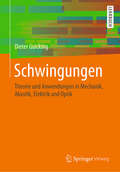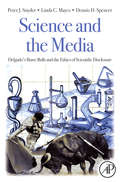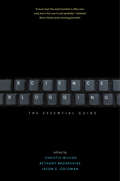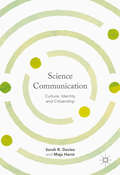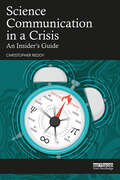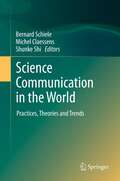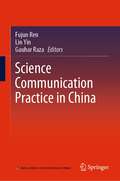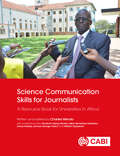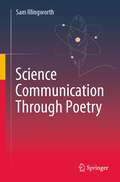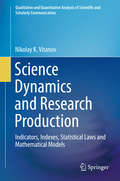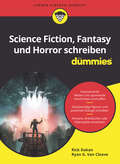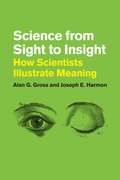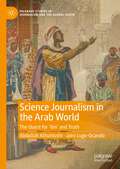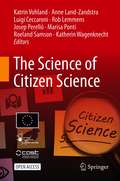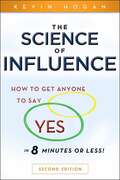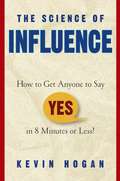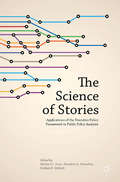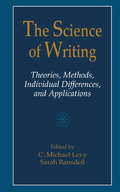- Table View
- List View
Schwingungen: Theorie und Anwendungen in Mechanik, Akustik, Elektrik und Optik
by Dieter GuickingDieses Buch vermittelt die gemeinsamen Grundlagen der Schwingungsmechanik, Akustik, Nachrichtentechnik und Hochfrequenztechnik. Immer wieder die Analogien zwischen mechanischen und elektrischen Schwingungen betonend, vereinigt diese Darstellung die Herleitung theoretischer Zusammenhänge, physikalisch-anschauliche Interpretationen und Hinweise auf technische Anwendungen. Durch ihre Gründlichkeit und Vielseitigkeit ist diese "Schwingungslehre" nicht nur als Lehrbuch interessant, sondern auch als Nachschlagewerk für den im praktischen Beruf oder als Hochschullehrer tätigen Physiker und Ingenieur.
Science and the Media: Delgado's Brave Bulls and the Ethics of Scientific Disclosure
by Peter J. Snyder Linda C. Mayes Dennis SpencerOf great utility for every scientist faced with publicizing their discoveries via the media, this book addresses questions of responsibility for the balance and accuracy of scientific reporting, and attempts to be a guide for the scientist in their quest to inform the general public about their research in honest, truthful, and still interesting ways. Case studies by leading scholars in the fields of bioethics (pharmaceutical research (Declan Doogan, Senior VP Pfizer), medical journal editing (Jerome Kassirer, former editor of NEJM), science journalism, philosophy of science, history of medicine (John Warner, chair history of medicine Yale), public health (Ruth Katz, Dean public health, George Washington University), and philosophy of religion (Reverend Wesley Carr, former Dean of Westminster) illustrate positions and points of view and offer unique perspectives on the complex dance between science and the media.Provides a compelling overview and analysis of the difficulties of dealing with mass media and collects tips and solutions.Includes case studies from the experience of a number of high-profile contributors from different fieldsProvides an easy-to-read, carefully selected and synthesized overview well suited to teaching and as further reading source in respective classesIncludes a famous movie from Jose Delgado that shows his attempts in the 60s to demonstrate "remote control" of a bull
Science Blogging: The Essential Guide
by Christie Wilcox Bethany Brookshire Jason G. GoldmanHere is the essential how-to guide for communicating scientific research and discoveries online, ideal for journalists, researchers, and public information officers looking to reach a wide lay audience. Drawing on the cumulative experience of twenty-seven of the greatest minds in scientific communication, this invaluable handbook targets the specific questions and concerns of the scientific community, offering help in a wide range of digital areas, including blogging, creating podcasts, tweeting, and more. With step-by-step guidance and one-stop expertise, this is the book every scientist, science writer, and practitioner needs to approach the Wild West of the Web with knowledge and confidence.
Science Communication: Culture, Identity and Citizenship
by Sarah R. Davies Maja HorstThis book describes current practices in science communication, from citizen science to Twitter storms, and celebrates this diversity through case studies and examples. However, the authors also reflect on how scholars and practitioners can gain better insight into science communication through new analytical methods and perspectives. From science PR to the role of embodiment and materiality, some aspects of science communication have been under-studied. How can we better notice these? Science Communication provides a new synthesis for Science Communication Studies. It uses the historical literature of the field, new empirical data, and interdisciplinary thought to argue that the frames which are typically used to think about science communication often omit important features of how it is imagined and practised. It is essential reading for students, scholars, and practitioners of science education, science and technology studies, museum studies, and media and communication studies.
Science Communication in a Crisis: An Insider's Guide
by Christopher ReddyScience Communication in a Crisis: An Insider’s Guide identifies the principal challenges that scientists face when communicating with different stakeholder groups and offers advice on how to navigate the maze of competing interests and deliver actionable science when the clock is ticking. If a scientist’s goal is to deliver content and expertise to the people who need it, then other stakeholder groups—the media, the government, industry—need to be considered as partners to collaborate with in order to solve problems. Written by established scientist Christopher Reddy, who has been on the front lines of several environmental crisis events, the book highlights ten specific challenges and reflects on mistakes made and lessons learned. Reddy’s aim is not to teach scientists how to ace an interview or craft a soundbite, rather, through exploring several high-profile case studies, including the North Cape oil spill, Deepwater Horizon, and the 2021 Sri Lanka shipping disaster, he presents a clear pathway to effective and collaborative communication. This book will be a great resource for junior and established scientists who want to make an impact, as well as students in courses such as environmental and science communication.
Science Communication in a Crisis: An Insider's Guide
by Christopher ReddyScience Communication in a Crisis: An Insider’s Guide identifies the principal challenges that scientists face when communicating with different stakeholder groups and offers advice on how to navigate the maze of competing interests and deliver actionable science when the clock is ticking. If a scientist’s goal is to deliver content and expertise to the people who need it, then other stakeholder groups—the media, the government, industry—need to be considered as partners to collaborate with in order to solve problems. Written by established scientist Christopher Reddy, who has been on the front lines of several environmental crisis events, the book highlights ten specific challenges and reflects on mistakes made and lessons learned. Reddy’s aim is not to teach scientists how to ace an interview or craft a soundbite, rather, through exploring several high-profile case studies, including the North Cape oil spill, Deepwater Horizon, and the 2021 Sri Lanka shipping disaster, he presents a clear pathway to effective and collaborative communication. This book will be a great resource for junior and established scientists who want to make an impact, as well as students in courses such as environmental and science communication.
Science Communication in the World: Practices, Theories and Trends
by Bernard Schiele, Michel Claessens and Shunke ShiThis volume is aimed at all those who wonder about the mechanisms and effects of the disclosure of knowledge. Whether they have a professional interest in understanding these processes generally, or they wish to conduct targeted investigations in the PCST field, it will be useful to anyone involved in science communication, including researchers, academics, students, journalists, science museum staff, scientists high public profiles, and information officers in scientific institutions.
Science Communication Practice in China
by Fujun Ren Lin Yin Gauhar RazaChina has made remarkable and rapid progress in the area of science communication, both in theory and practice. This book critically examines all aspects of science communication practices in China. Dealing with major turning points since the introduction of the ‘Science and Technology Popularization Law’ and the ‘Outline of the National Scheme for Scientific Literacy’, the book tells a success story by scrutinizing structural changes in science communication policies, education system, construction and efficacious utilisation of science popularisation facilities, and creative use of a mix of traditional and modern channels of communication. The book also gives an in-depth analysis of the monitoring and evaluation mechanism, which constitutes the backbone of the national science communication project. The historical roots of science communication in China include shifts in methodologies, policy instruments, effectual approaches and resultant practices since the days of initial efforts to popularise modern scientific ideas. However, the primary focus of the book remains on the initiatives launched at the turn of the present century. Without losing sight of the national dimensions, each chapter of the book draws from provincial as well as grassroots level experiences. Quantitative and qualitative methods have been used to analyse strengths, weaknesses, hurdles and the efficacy of corrective measures. This book offers a remarkable insight to anyone who is interested in probing the causal relationship between science communication and China’s transformation into a modern society. The primary objective of the book is to analyse the nature of ‘science communication with Chinese characteristics’ and the specificity of the socio-cultural environment in which Science and Technology is located. Though the book is of particular interest to scholars, researchers, students and practitioners of science communication, the narrative style makes it accessible to the general reader who is interested in science-society relationship.
Science Communication Skills for Journalists: A Resource Book for Universities in Africa
by Charles WendoThis book has an introduction and 22 other chapters that cover science communication skills. The editor has detailed knowledge of the field and consultation with leading editors and journalists in the region. It provides hands-on guidance together with examples, learning activities, graded and ungraded quizzes to facilitate learning. The content has been tried and tested by lecturers at two universities in Nigeria and Uganda, who used it to successfully train thousands of students in science communication. Each chapter carries hands-on advice on the practice of science journalism, with learning activities to deepen the learner's understanding of the topic. The book also includes five academic systematic review papers, written by university faculty, that that identify, review and synthesize available literature and experiences on science journalism and communication issues in the region. It also includes a case study detailing the experience of Uganda's Makerere University in introducing science journalism and communication into their undergraduate and post-graduate curricula.
Science Communication Through Poetry
by Sam IllingworthScience Communication Through Poetry aims to explore how we might communicate science effectively both to and with non-scientific audiences across the spectrum of science communication, from dissemination to dialogue, via the medium of poetry. It has been written for scientists, science communicators, public engagement practitioners, and poets, so that they can learn how to use poetry as an effective tool through which to diversify science. As well as containing specific advice and guidance for how to use poetry to communicate science with different audiences, this book contains a number of exercises for the reader to reflect on what has been learnt and to put into practice what is discussed. Further study and additional readings are also provided to help improve knowledge, understanding, and familiarity with both poetry and science communication.
Science Dynamics and Research Production: Indicators, Indexes, Statistical Laws and Mathematical Models (Qualitative and Quantitative Analysis of Scientific and Scholarly Communication)
by Nikolay K. VitanovThis book deals with methods to evaluate scientific productivity. In the book statistical methods, deterministic and stochastic models and numerous indexes are discussed that will help the reader to understand the nonlinear science dynamics and to be able to develop or construct systems for appropriate evaluation of research productivity and management of research groups and organizations. The dynamics of science structures and systems is complex, and the evaluation of research productivity requires a combination of qualitative and quantitative methods and measures. The book has three parts. The first part is devoted to mathematical models describing the importance of science for economic growth and systems for the evaluation of research organizations of different size. The second part contains descriptions and discussions of numerous indexes for the evaluation of the productivity of researchers and groups of researchers of different size (up to the comparison of research productivities of research communities of nations). Part three contains discussions of non-Gaussian laws connected to scientific productivity and presents various deterministic and stochastic models of science dynamics and research productivity. The book shows that many famous fat tail distributions as well as many deterministic and stochastic models and processes, which are well known from physics, theory of extreme events or population dynamics, occur also in the description of dynamics of scientific systems and in the description of the characteristics of research productivity. This is not a surprise as scientific systems are nonlinear, open and dissipative.
Science Fiction, Fantasy und Horror schreiben für Dummies (Für Dummies)
by Rick Dakan Ryan G. Van CleaveSie spielen schon lange mit dem Gedanken, ein Science-Fiction-, Fantasy- oder Horrorwerk zu schreiben, aber Sie wissen nicht, wie Sie es angehen sollen? Oder Sie sind vielleicht schon mitten im Schreibprozess, aber kommen nicht weiter? Dieses Buch liefert Ihnen alle Basics, die Sie brauchen, um faszinierende Welten und packende Charaktere zu erschaffen. Lernen Sie Strategien, um Geschichten aus verschiedenen Genres zu schreiben, zum Beispiel Romane, Kurzgeschichten, Videospiele oder Drehbücher. Anschließend geht es um das spezifische Handwerkszeug für Science-Fiction-, Fantasy- und Horrortexte. Zu guter Letzt geben Ihnen die Autoren auch Tipps, wie Sie Ihr Buch lektorieren, einen Agenten finden oder Ihr Buch per Self-Publishing auf den Markt bringen. So wird aus Ihnen vielleicht bald der nächste Tolkien, King oder Asimov!
Science from Sight to Insight: How Scientists Illustrate Meaning
by Alan G. Gross Joseph E. HarmonJohn Dalton’s molecular structures. Scatter plots and geometric diagrams. Watson and Crick’s double helix. The way in which scientists understand the world—and the key concepts that explain it—is undeniably bound up in not only words, but images. Moreover, from PowerPoint presentations to articles in academic journals, scientific communication routinely relies on the relationship between words and pictures. In Science from Sight to Insight, Alan G. Gross and Joseph E. Harmon present a short history of the scientific visual, and then formulate a theory about the interaction between the visual and textual. With great insight and admirable rigor, the authors argue that scientific meaning itself comes from the complex interplay between the verbal and the visual in the form of graphs, diagrams, maps, drawings, and photographs. The authors use a variety of tools to probe the nature of scientific images, from Heidegger’s philosophy of science to Peirce’s semiotics of visual communication. Their synthesis of these elements offers readers an examination of scientific visuals at a much deeper and more meaningful level than ever before.
Science from Sight to Insight: How Scientists Illustrate Meaning
by Alan G. Gross Joseph E. HarmonJohn Dalton’s molecular structures. Scatter plots and geometric diagrams. Watson and Crick’s double helix. The way in which scientists understand the world—and the key concepts that explain it—is undeniably bound up in not only words, but images. Moreover, from PowerPoint presentations to articles in academic journals, scientific communication routinely relies on the relationship between words and pictures. In Science from Sight to Insight, Alan G. Gross and Joseph E. Harmon present a short history of the scientific visual, and then formulate a theory about the interaction between the visual and textual. With great insight and admirable rigor, the authors argue that scientific meaning itself comes from the complex interplay between the verbal and the visual in the form of graphs, diagrams, maps, drawings, and photographs. The authors use a variety of tools to probe the nature of scientific images, from Heidegger’s philosophy of science to Peirce’s semiotics of visual communication. Their synthesis of these elements offers readers an examination of scientific visuals at a much deeper and more meaningful level than ever before.
Science from Sight to Insight: How Scientists Illustrate Meaning
by Alan G. Gross Joseph E. HarmonJohn Dalton’s molecular structures. Scatter plots and geometric diagrams. Watson and Crick’s double helix. The way in which scientists understand the world—and the key concepts that explain it—is undeniably bound up in not only words, but images. Moreover, from PowerPoint presentations to articles in academic journals, scientific communication routinely relies on the relationship between words and pictures. In Science from Sight to Insight, Alan G. Gross and Joseph E. Harmon present a short history of the scientific visual, and then formulate a theory about the interaction between the visual and textual. With great insight and admirable rigor, the authors argue that scientific meaning itself comes from the complex interplay between the verbal and the visual in the form of graphs, diagrams, maps, drawings, and photographs. The authors use a variety of tools to probe the nature of scientific images, from Heidegger’s philosophy of science to Peirce’s semiotics of visual communication. Their synthesis of these elements offers readers an examination of scientific visuals at a much deeper and more meaningful level than ever before.
Science from Sight to Insight: How Scientists Illustrate Meaning
by Alan G. Gross Joseph E. HarmonJohn Dalton’s molecular structures. Scatter plots and geometric diagrams. Watson and Crick’s double helix. The way in which scientists understand the world—and the key concepts that explain it—is undeniably bound up in not only words, but images. Moreover, from PowerPoint presentations to articles in academic journals, scientific communication routinely relies on the relationship between words and pictures. In Science from Sight to Insight, Alan G. Gross and Joseph E. Harmon present a short history of the scientific visual, and then formulate a theory about the interaction between the visual and textual. With great insight and admirable rigor, the authors argue that scientific meaning itself comes from the complex interplay between the verbal and the visual in the form of graphs, diagrams, maps, drawings, and photographs. The authors use a variety of tools to probe the nature of scientific images, from Heidegger’s philosophy of science to Peirce’s semiotics of visual communication. Their synthesis of these elements offers readers an examination of scientific visuals at a much deeper and more meaningful level than ever before.
Science from Sight to Insight: How Scientists Illustrate Meaning
by Alan G. Gross Joseph E. HarmonJohn Dalton’s molecular structures. Scatter plots and geometric diagrams. Watson and Crick’s double helix. The way in which scientists understand the world—and the key concepts that explain it—is undeniably bound up in not only words, but images. Moreover, from PowerPoint presentations to articles in academic journals, scientific communication routinely relies on the relationship between words and pictures. In Science from Sight to Insight, Alan G. Gross and Joseph E. Harmon present a short history of the scientific visual, and then formulate a theory about the interaction between the visual and textual. With great insight and admirable rigor, the authors argue that scientific meaning itself comes from the complex interplay between the verbal and the visual in the form of graphs, diagrams, maps, drawings, and photographs. The authors use a variety of tools to probe the nature of scientific images, from Heidegger’s philosophy of science to Peirce’s semiotics of visual communication. Their synthesis of these elements offers readers an examination of scientific visuals at a much deeper and more meaningful level than ever before.
Science from Sight to Insight: How Scientists Illustrate Meaning
by Alan G. Gross Joseph E. HarmonJohn Dalton’s molecular structures. Scatter plots and geometric diagrams. Watson and Crick’s double helix. The way in which scientists understand the world—and the key concepts that explain it—is undeniably bound up in not only words, but images. Moreover, from PowerPoint presentations to articles in academic journals, scientific communication routinely relies on the relationship between words and pictures. In Science from Sight to Insight, Alan G. Gross and Joseph E. Harmon present a short history of the scientific visual, and then formulate a theory about the interaction between the visual and textual. With great insight and admirable rigor, the authors argue that scientific meaning itself comes from the complex interplay between the verbal and the visual in the form of graphs, diagrams, maps, drawings, and photographs. The authors use a variety of tools to probe the nature of scientific images, from Heidegger’s philosophy of science to Peirce’s semiotics of visual communication. Their synthesis of these elements offers readers an examination of scientific visuals at a much deeper and more meaningful level than ever before.
Science Journalism in the Arab World: The Quest for ‘Ilm’ and Truth (Palgrave Studies in Journalism and the Global South)
by Abdullah Alhuntushi Jairo Lugo-OcandoThis book examines the main issues and challenges that science journalism faces in the MENA region while analyzing how journalists in these countries cover science and engage with scientists. Most countries in the Middle East and North Africa region have set an ambitious goal for 2030: to transform their societies and become knowledge economies. This means modernizing institutions and encouraging people to embrace Science, Technology, Engineering and Mathematics as part of their daily lives. This books claims that the main vehicle to achieve this goal is science news reporting, as it continues to be the main platform to disseminate scientific knowledge to the general public. Simultaneously, it is also poorly equipped to achieve this task. Interviewing dozens of journalists, the authors looked at specific areas such as the gender divide and its effects on science news reporting as well as the role of religion and culture in shaping journalism as a political institution. The authors conclude that traditional normative assumptions as to why science reporting does not live up to expectations need to be reviewed in light of other more structural problems such as lack of skills and specialization in science communication in the region. In so doing, the book sets out to understand the past, present and future of science news in one of the most challenging regions in the world for journalists.
The Science of Citizen Science
by Roeland Samson Katrin Vohland Anne Land-Zandstra Luigi Ceccaroni Rob Lemmens Josep Perelló Marisa Ponti Katherin WagenknechtThis open access book discusses how the involvement of citizens into scientific endeavors is expected to contribute to solve the big challenges of our time, such as climate change and the loss of biodiversity, growing inequalities within and between societies, and the sustainability turn. The field of citizen science has been growing in recent decades. Many different stakeholders from scientists to citizens and from policy makers to environmental organisations have been involved in its practice. In addition, many scientists also study citizen science as a research approach and as a way for science and society to interact and collaborate. This book provides a representation of the practices as well as scientific and societal outcomes in different disciplines. It reflects the contribution of citizen science to societal development, education, or innovation and provides and overview of the field of actors as well as on tools and guidelines. It serves as an introduction for anyone who wants to get involved in and learn more about the science of citizen science.
The Science of Influence: How to Get Anyone to Say "Yes" in 8 Minutes or Less!
by Kevin HoganGet customers, clients, and co-workers to say "yes!" in 8 minutes or less This revised second edition by a leading expert of influence continues to teach a proven system of persuasion. Synthesizing the latest research in the field of influence with real-world tested experiences, it presents simple secrets that help readers turn a "no" into a "yes." Every secret in this book has been rigorously tested, validated, and found reliable. Learn dozens of all-new techniques and strategies for influencing others including how to reduce resistance to rubble Make people feel instantly comfortable in your presence Decode body language, build credibility, and be persistent without being a pain Expert author Kevin Hogan turns the enigmatic art of influence and persuasion into a science anyone can master The amazing secret of The Science of Influence is its simplicity. After you read this book you will immediately understand why people say "no" to you and learn how to turn that "no" into a "yes" from that moment on.
The Science of Influence: How to Get Anyone to Say "Yes" in 8 Minutes or Less!
by Kevin HoganNew secrets to getting what you want every time The Science of Influence shows readers how to get anyone to say "yes" in eight minutes or less. Synthesizing the latest research in the field of influence with real-world tested experiences, it presents simple secrets that help readers turn a "no" into a "yes." Every secret in this book has been rigorously tested, validated, and found reliable academically and in the real world. Readers learn dozens of all-new techniques and strategies for influencing others including how to reduce resistance to rubble; send unconscious nonverbal messages that are consciously undetectable; make people feel instantly comfortable in your presence; decode body language; build credibility; and be persistent without being a pain. The Science of Influence turns the enigmatic art of influence and persuasion into a science anyone can master. Kevin Hogan, PsyD (Eagan, MN), is a dynamic motivational speaker and expert on unconscious influence and body language for the BBC, the New York Post, and such popular magazines as Cosmopolitan and Playboy. He teaches Persuasion and Influence at the University of St. Thomas Management Center. He is the author of 12 books including bestsellers such as Irresistible Attraction: Secrets of Personal Magnetism and The Psychology of Persuasion.
The Science of Influence: How to Get Anyone to Say "Yes" in 8 Minutes or Less!
by Kevin HoganGet customers, clients, and co-workers to say "yes!" in 8 minutes or less This revised second edition by a leading expert of influence continues to teach a proven system of persuasion. Synthesizing the latest research in the field of influence with real-world tested experiences, it presents simple secrets that help readers turn a "no" into a "yes." Every secret in this book has been rigorously tested, validated, and found reliable. Learn dozens of all-new techniques and strategies for influencing others including how to reduce resistance to rubble Make people feel instantly comfortable in your presence Decode body language, build credibility, and be persistent without being a pain Expert author Kevin Hogan turns the enigmatic art of influence and persuasion into a science anyone can master The amazing secret of The Science of Influence is its simplicity. After you read this book you will immediately understand why people say "no" to you and learn how to turn that "no" into a "yes" from that moment on.
The Science of Stories: Applications of the Narrative Policy Framework in Public Policy Analysis
by Michael D. Jones Elizabeth A. Shanahan Mark K. McBethThe study of narratives in a variety of disciplines has grown in recent years as a method of better explaining underlying concepts in their respective fields. Through the use of Narrative Policy Framework (NPF), political scientists can analyze the role narrative plays in political discourse.
The Science of Writing: Theories, Methods, Individual Differences and Applications
by C. Michael Levy Sarah RansdellConceived as the successor to Gregg and Steinberg's Cognitive Processes in Writing, this book takes a multidisciplinary approach to writing research. The authors describe their current thinking and data in such a way that readers in psychology, English, education, and linguistics will find it readable and stimulating. It should serve as a resource book of theory, tools and techniques, and applications that should stimulate and guide the field for the next decade. The chapters showcase approaches taken by active researchers in eight countries. Some of these researchers have published widely in their native language but little of their work has appeared in English-language publications.
